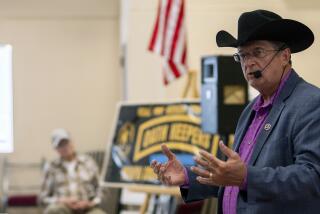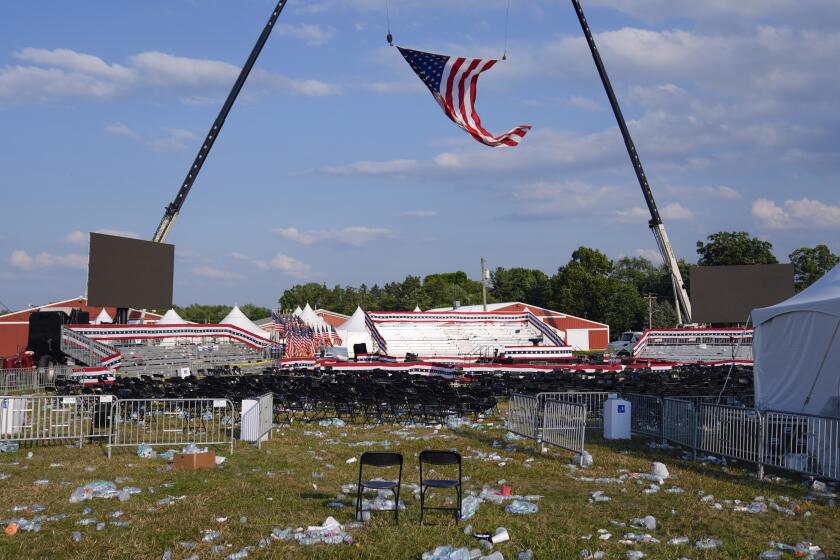Mexican drug lord Teodoro Garcia Simental, known for his savagery, is captured
A Mexican drug cartel kingpin accused of dissolving victims in barrels of lye and waging a terror campaign that turned Tijuana into one of Mexico’s most dangerous cities was captured early Tuesday in the port city of La Paz, federal authorities said.
Teodoro Garcia Simental, blamed for a years-long campaign of massacres, beheadings and kidnappings that chased away tourists and caused social upheaval in northern Baja California, was arrested by Mexican federal police without the suspect firing a shot, and immediately flown to Mexico City.
The heavyset Garcia, believed to be in his mid-30s, with close-trimmed hair and a goatee, scowled and dabbed at his mouth as he was paraded before television cameras at a police base wearing a zippered warm-up jacket.
Better known for savage killing rampages than narco-business acumen, the man nicknamed “El Teo” bedeviled Mexican authorities for years and narrowly escaped capture several times. Last January, authorities arrested the man they said admitted being Garcia’s body disposal expert. Known as El Pozolero, or “the stew maker,” he claimed, authorities said, to have dissolved 300 bodies in barrels of caustic chemicals.
Mexican federal authorities, acting on intelligence provided by the U.S. Drug Enforcement Administration, said they tracked Garcia down after a five-month surveillance operation. He was captured in an upscale area in the southern part of the city.
“Today another Mexican cartel leader was taken off the street and is no longer able to carry out his bloody turf war,” said Michele Leonhart, acting administrator of the DEA. “This was not an isolated event: It exemplifies the growing effectiveness of our information sharing with [Mexican President Felipe Calderon’s] administration, and our continued commitment to defeat the drug traffickers who have plagued both our nations.”
Though Garcia was not considered to be in the top echelon of Mexican drug lords, few reputed crime bosses have had such a ruinous effect on a region. Mexican authorities say he was responsible for hundreds of killings during a nearly two-year power struggle with rivals in the Arellano Felix drug cartel, in which he had once been a top-ranking lieutenant.
Garcia is said to have branched out from traditional drug trafficking and focused his criminal empire on extortion and kidnapping, targeting all levels of society. During his reign, hundreds, perhaps thousands, of Tijuana residents moved out of the border city to avoid being kidnapped, and more than 42 police officers were killed.
“It’s a very good day for Tijuana,” said former resident Gabriel Benavides, whose family moved to a San Diego suburb after a loved one was kidnapped by Garcia’s crew in 2005. “He caused great pain to so many people.”
The arrest was a dose of good news amid a spectacular surge in violence in drug-trafficking zones across Mexico. The country had already seen unprecedented bloodshed resulting from gang turf wars and the government’s 3-year-old crackdown on organized crime.
In Tijuana, where more than 30 people have died this month, government officials hope that Garcia’s arrest will bring some tranquillity. His main rival, Fernando Sanchez Arellano, could fill the power vacuum and impose order in the criminal underworld. But many observers warned that there could be fresh rounds of violence if one of Garcia’s lieutenants makes a power play.
Garcia started as an errand boy for the Arellano Felix cartel and reputedly rose to power as the leader of a cell that turned kidnappings for ransom into a rich vein of revenue. Hundreds of residents -- attorneys, prominent businessmen, doctors -- were abducted and held at safe houses across the city.
When Sanchez Arellano, the cartel leader, tried to rein in his lieutenant, Garcia resisted and war broke out after a shootout between the rival gangs in April 2008 that left at least 13 people dead.
Much of Tijuana became a battleground and Garcia gained notoriety for ruthless and depraved tactics. Rivals were massacred, burned and tossed into vacant lots. Mutilated bodies were hung from freeway overpasses.
Last year, Mexican authorities started striking hard against Garcia, arresting several of his lieutenants in blows that choked off revenue and depleted his ranks of enforcers. Authorities last January came close to arresting Garcia at a resort south of Rosarito Beach where his gang was gathering for a party. He eluded capture by escaping down the beach that is popular with American retirees.
In recent months, the manhunt intensified and Garcia avoided going to Tijuana. Authorities had narrowed his whereabouts to southern Baja California and pinpointed his house through electronic surveillance of his telephone, according to a U.S. law enforcement official.
Times staff writer Tracy Wilkinson in Mexico City contributed to this report.
More to Read
Sign up for Essential California
The most important California stories and recommendations in your inbox every morning.
You may occasionally receive promotional content from the Los Angeles Times.











